

Vermont, located in New-England is the forteenth state of the USA. Vermont was
an
independant state between 1777 and 1791 and then join the thirteen first states of the USA.
This chapter of the Theudericus site will only covers the French period of the history of Vermont i.e. between 1609 and 1763.
This state has been discovered in July 1609 by The French noble Samuel de Champlain, born at
Brouage in Saintonge, while
upstreaming the Saint Lawrence river and the Iroquois river (know today as Richelieu river) discovered a great lake which was called
Champlain Lake. Looking at the mountains range which spread along the lake, Champlain calles this country les "Verts Monts" (The
Green Montains).
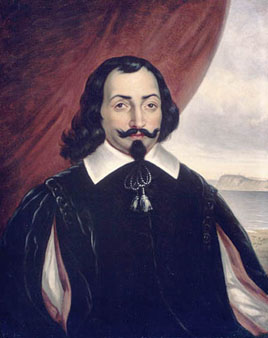
Thus, Vermont or more precisely the plain leaning betwen the lake and the mountain range belonged to the "Nouvelle-France" (The New-France).
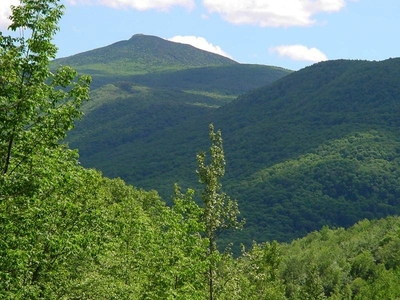
In fact, several forts were established by the French along this strategic communication line (Fort Richelieu, Saint Louis, Fort Thérèse, Fort Saint Jean). In the country of the Gree Mountains were built the Fort Sainte Anne, first White settlement in Vermont created in 1666 on the Island of La Motte and the Fort Carillon (The last one will be renamed after 1763 : Fort Ticonderoga)
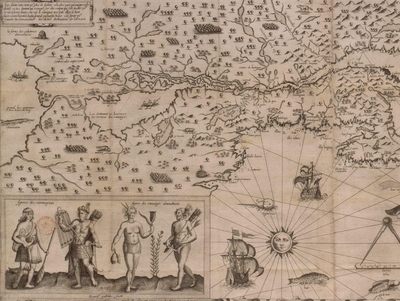
The French forts mentionned above are seen on this map with their date of built.
The French colonisation of Vermont spreads over the XVIIth and XVIIIthe century. But the British pressure due to its strong immigration is drastically increasing over the New-France.
in 1750, the sporadic but dramatic fights became a true colonial war. At first, this war was located in the Champlain valley and the Ohio valley.
The Marquis of Montcalm, chief commander of the French troops stopped in July 1758 the British army at Fort Carillon in the South of Vermont. With near of 4 000 men, Montcalm succeded in stopping the British assaults during all the day. At seven o'clock in the evening the British army is severely defeated : 1 940 deads and wounded in the British camp versus 380 lost men in the French camp.
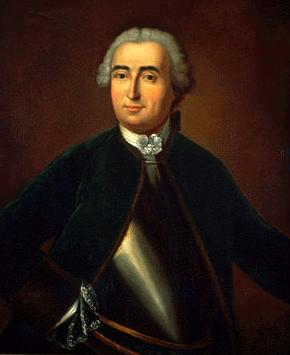
But this magnificent victory won in Vermont was not enough to save the "Nouvelle-France." The British army is strong of nearly 4à 000 men facing almost 8 000 French soldiers. This British army which was commanded by the general James Wolfe has for main objective the hearth of the New-France : Quebec-city.
In 1759, despite the strong resistance of the forts of the Champlain lake, Richelieu river, and Saint-Lawrence river, the British army succedeed in reaching the Low saint-Lawrence.
The siege of Quebec-city started on June 21th 1759. 6 000 French soldiers and milicians defend the main city of the "Nouvelle-France", facing 42 000 Britishs.
During the night of September 12th to 13th, the British army performed a rolling movement and took position settled in theplains of Abraham,
, located few miles away from the city.
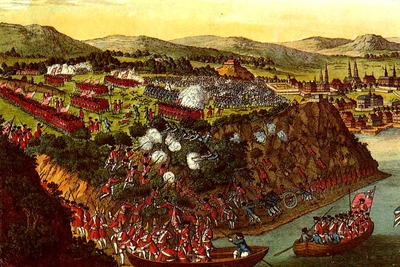
The battle which decided the future of the "Nouvelle-France" will occur in the funest location.
On September 14th, Montcalm died in Quebec, as well as the general Wolfe. Quebec taken, France
cannot win this war anymore.
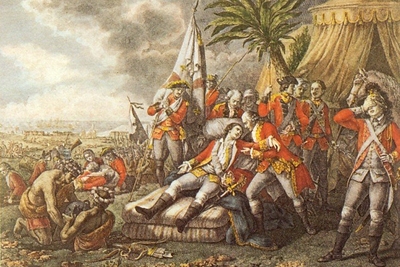

While the Court of New-York refuse to recognized the validity of the documents issued by the le New Hampshire confirming
the properties documents of the colons, Ethan Allen organize at Bennington an armed une milice of two hundreds colons : the
rebel army of "The Green Mountain Boys" is born.
En 1771, New-Yorks agents are back an throw away by the "The Green Mountain Boys" : It is a real war which began betwwe
what will be soon the Vermont and the colony of New-York.
For years later, the Independance War between England and its colonies of America, did not weak the severe conflict
between the "The Green Mountain Boys" and New-York. In May 1775, the army commanded by Ethan Allen attacks and take
the Fort of Ticonderoga, winning a strategic and definitive victory in front of the forces of New-York.
In 1777, a Convention is held at à Westminster and claim the Independance of the Republic of "New Connecticut". A
Constitution is written. A new Convention in July of the same year give the name of Vermont to the young Republic.

In 1781, the British try without success to take Ticonderoga from the New republic. The Vermonters, while independant,
get much closer to the new American Confederation.
Finally, the Treaty of Versailles signed in 1783 which end the war of Independance, defined Vermont as part of the American sphere.
In 1789, a mixt commission mixte « New-York/Vermont » ends the question of the boundaries between vermont and New-York (Versus
the paiment of thirty thousands dollars, New York withdraw definitively its revendications about Vermont) : In 1791, Vermont
join the Union.
Vermont which kept its French original name is called the "Green Mountains State".
Vermont State City is Montpelier, but the largest city of Vermont is Burlington, located on the Champlain Lake.
Please find here below images on two chapters of the Theudericus's site :
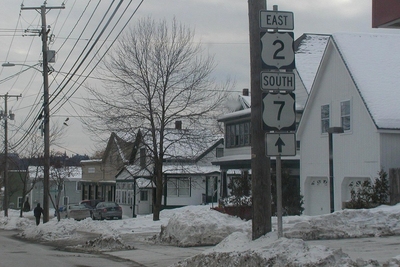
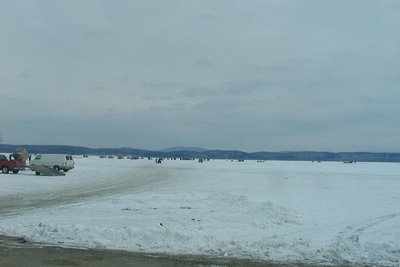

![]() Back to Home Page.
Back to Home Page.
.